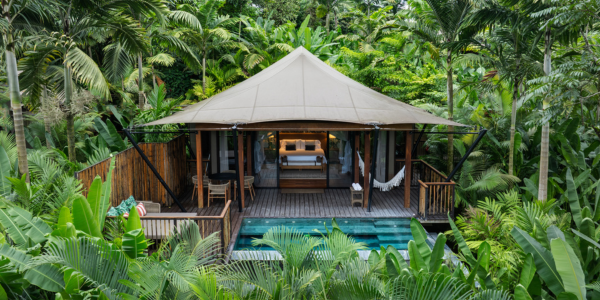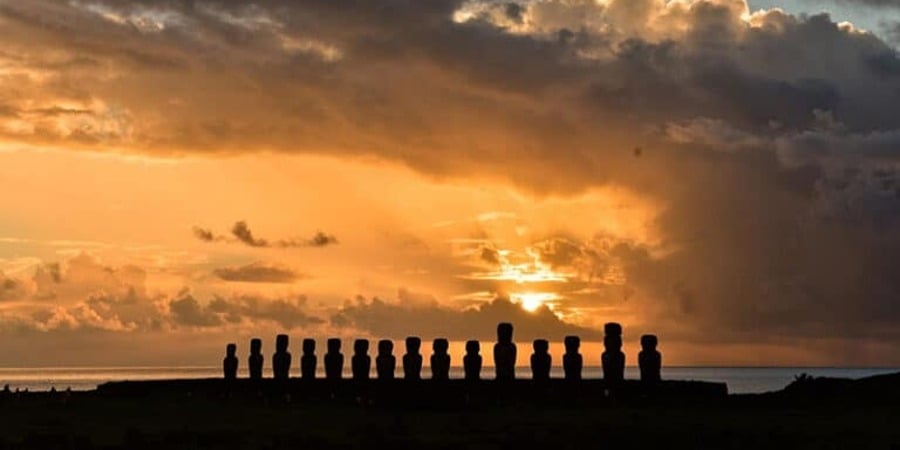
How Nayara Hangaroa Leads Regeneration on Rapa Nui

Centuries ago, a small wooden canoe appeared over the endless blue, carrying a handful of Polynesian voyagers who had followed the stars across thousands of kilometers of open ocean. Among them were the ancestors of the Hito family. Guided by birds, currents, and memory, they landed on a volcanic speck of land now known as Rapa Nui. In that moment of arrival, balance began — a fragile dialogue between people and place that continues today.
This story looks across the Pacific, to a living network: one of kinship, cultural transmission, and stewardship. On this remote island, regeneration does not sprout from forest soil but from stone, coral, and community.
From Carvers of Stone to Guardians of Culture
For centuries, Rapa Nui flourished. Families cultivated manavai gardens, circular rock enclosures that protected crops from wind and preserved moisture in volcanic soil. Communities fished sustainably, farmed communally, and lived according to navigational knowledge carried across the Pacific.
From the slopes of Rano Raraku came the Moai. These enormous stone figures honored ancestors and held mana, the spiritual energy that protected the living. Facing inland, they watched over villages and helped maintain a balance between people and place.
That balance began to strain. Trees were cleared to move the Moai, and the island’s palm forests eventually vanished. Without timber, canoes could no longer be built for deep-sea fishing. Soil eroded. Birds disappeared. The relationship between community and environment fractured.
By the seventeenth century, rival clans fought for resources. Moai were toppled not in defiance, but in grief. When Europeans arrived in 1722, they found an island stripped of trees yet rich in resilience. Rapa Nui would eventually recover, but only through a renewed understanding of stewardship.
The Hito Legacy
Among the lineages that carried the island’s memory forward is the Hito family. Their ancestors carved Moai, farmed the rocky soil, and fished the surrounding reefs. Through colonization, disease, and exile, they preserved the traditions of stewardship that had shaped Rapa Nui for centuries.
Today the Hito family are guardians of both heritage and habitat, and part-owners of Nayara Hangaroa. They plant toromiro and makoi trees on ancestral land once left barren. They collaborate with scientists and artists to protect coral reefs, restore soils, and teach the next generation what balance truly means.
“The Moai remind us to walk carefully,” says one elder of the family. “They face inward because they protect the people, not themselves.”
At Nayara Hangaroa, design follows the island’s contours rather than defying them. Roofs arch like lava flows, and walls are built from volcanic stone. Solar energy powers operations, water is reused through natural filtration, and organic material is returned to the soil as compost. The principles that guided the first settlers — living within the island’s limits — now guide its regeneration.
The Science of Walking Giants
For centuries, the mystery of how the moai moved puzzled historians. Were they dragged on wooden sledges? Rolled on logs? Modern research led by archaeologists Carl Lipo and Terry Hunt revealed that the statues were walked. With ropes and rhythm, teams could tilt each moai upright. By shifting weight side to side, they walked it forward until it reached its resting place.
The discovery confirmed what Rapa Nui oral tradition had always said: the moai walked with mana. The ancestors’ energy moved through community cooperation, not machinery.
It was both a scientific revelation and a cultural vindication. What once seemed like myth became proof that belief and physics can coexist. The moai walked because the people walked together.
Collapse and Renewal
Jared Diamond once called Rapa Nui the clearest example of ecological collapse in human history. Yet that label misses the second half of the story: renewal.
Today, forests are returning. Coral reefs are recovering. Traditional agriculture and fishing are being revived through community education. The same ingenuity that built the moai is now rebuilding the ecosystem.
The toromiro tree, long extinct in the wild, has been reintroduced through a global collaboration between Rapa Nui families and botanical gardens. Each new sapling represents both science and faith. The coral reefs around the island, once bleached and lifeless, are showing color again thanks to local conservation programs that protect juvenile fish and prevent overharvesting.
Regeneration as Legacy
At Nayara Hangaroa, regeneration is not an initiative or activity. It is woven into daily life. Guests are invited to participate in restoration walks, tree-planting efforts, and coral-education programs, not as visitors but as contributors. Most of our team are Rapa Nui residents, and every part of the guest experience—from food sourcing to interpretation—supports the island’s stewardship.
The Hito family remains at the center of this philosophy. Their work reflects a shift from sustainable luxury to regenerative luxury, where the goal is not to minimize impact but to restore what has been lost. Their partnership guides how we care for the land, how we design, and how we welcome travelers into a place shaped by ancestry.
From the volcanic shores of Rapa Nui to the rainforests of Costa Rica, regeneration at Nayara begins and ends with respect. Each place teaches its own form of restoration, and each community shapes the practices that sustain identity. Together, they form a single purpose: to ensure travel gives back more than it takes.
Frequently Asked Questions
Who are the Hito family? The Hito family are a multigenerational Rapa Nui lineage descended from early Polynesian settlers. They are recognized for their cultural preservation work, leadership in reforestation and reef restoration, and stewardship of Nayara Hangaroa.
Why do the moai face inland?
Each moai faces its community to watch over the people. This reflects the belief that ancestral energy (mana) protects life, maintains balance, and connects families to their land.
What caused deforestation on Rapa Nui?
Centuries of overharvesting for agriculture and moving statues, combined with soil erosion and changing climate patterns, led to the island’s deforestation. Modern restoration projects now reintroduce native trees and protect remaining habitats.
How were the moai moved?
Archaeological research shows that the statues were walked using ropes, with teams shifting their weight side to side until they moved forward. This method aligns with Rapa Nui oral tradition, which has long said the moai “walked.”
What does regeneration mean on Rapa Nui today?
Regeneration focuses on restoring ecosystems and cultural practices. This includes reviving traditional agriculture, rebuilding coral reefs, planting native species, reducing waste, and involving local families in conservation and education.
How does Nayara Hangaroa support regeneration?
Nayara Hangaroa collaborates with Rapa Nui families, environmental groups, and cultural leaders to restore land and marine habitats. Efforts include composting organic material, supporting reforestation, reducing water use through natural filtration, and offering guest programs that contribute to local conservation.



.jpg)

